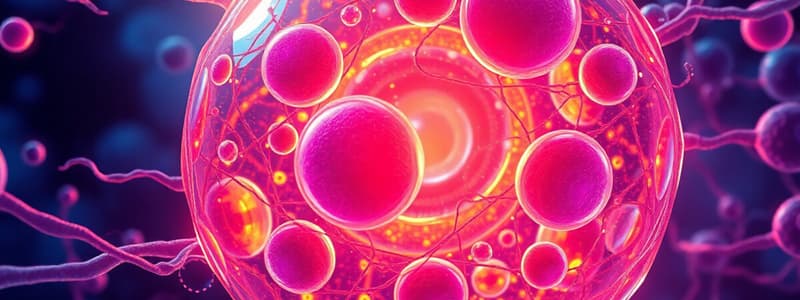Podcast
Questions and Answers
Which of the following cellular components is NOT part of the endomembrane system?
Which of the following cellular components is NOT part of the endomembrane system?
- Lysosome
- Endoplasmic reticulum
- Mitochondrion (correct)
- Golgi apparatus
A cell biologist is studying a newly discovered eukaryotic cell. Upon observation, they notice the cell has a rigid outer layer but lacks chloroplasts. Which of the following is the MOST likely classification for this cell?
A cell biologist is studying a newly discovered eukaryotic cell. Upon observation, they notice the cell has a rigid outer layer but lacks chloroplasts. Which of the following is the MOST likely classification for this cell?
- Animal cell
- Plant cell
- Fungal cell (correct)
- Protist cell
A researcher is examining a cell under an electron microscope and observes a structure with two membranes, and within it, stacks of flattened sacs called cristae. This structure is MOST likely involved in which of the following processes?
A researcher is examining a cell under an electron microscope and observes a structure with two membranes, and within it, stacks of flattened sacs called cristae. This structure is MOST likely involved in which of the following processes?
- Cellular respiration (correct)
- Lipid modification and sorting
- Protein synthesis
- Intracellular digestion
If a researcher wants to observe the detailed surface features of a virus, which type of microscopy would be MOST appropriate?
If a researcher wants to observe the detailed surface features of a virus, which type of microscopy would be MOST appropriate?
Which of the following is a key difference in the function of smooth ER compared to rough ER?
Which of the following is a key difference in the function of smooth ER compared to rough ER?
Flashcards
Light Microscope
Light Microscope
Uses visible light and lenses to magnify images. Advantages: can view living cells. Disadvantages: limited magnification and resolution.
Electron Microscope
Electron Microscope
Uses electron beams to magnify images. Advantages: much higher magnification and resolution. Disadvantages: samples must be non-living, complex preparation.
Plasma Membrane
Plasma Membrane
A selective barrier regulating passage in/out of the cell; made of a phospholipid bilayer.
Nucleus
Nucleus
Signup and view all the flashcards
Endoplasmic Reticulum (ER)
Endoplasmic Reticulum (ER)
Signup and view all the flashcards
Study Notes
- Light microscopes and electron microscopes each have distinct advantages and disadvantages.
- Three important parameters in microscopy must be considered.
- Prokaryotic and eukaryotic cells share similar functions.
- Key differences exist between prokaryotic and eukaryotic cells.
- Organelles are a structural and/or functional feature of cells, each with specific features.
- Specific information of the following structures:
Plasma Membrane
- Characterized by selective permeability.
Nucleus
- Contains most of the genes in the eukaryotic cell.
ER (Rough and Smooth)
- Smooth ER synthesizes lipids, metabolizes carbohydrates, and detoxifies drugs and poisons.
- Rough ER aids in the synthesis of proteins.
Golgi
- Receives transport vesicles from the ER.
Lysosomes
- A membranous sac of hydrolytic enzymes.
Peroxisomes
- Contains enzymes that remove hydrogen atoms from substances and transfer them to oxygen, producing hydrogen peroxide.
Vacuoles
- Large vesicles derived from the ER and Golgi apparatus.
Ribosomes
- Complexes made of ribosomal RNA and protein, and carry out protein synthesis.
Mitochondria
- Sites of cellular respiration, the metabolic process that uses oxygen to generate ATP.
Chloroplast
- Found in plants and algae, are the sites of photosynthesis.
- The endomembrane system members are related through direct contact or by transfer of membrane segments as vesicles.
- Two types of ribosomes are present with different components or functions.
- Lysosomes help in intracellular digestion in two ways.
- Endosymbiont theory needs to be understood.
- Three components make up the cytoskeleton and the makeup and functions of microfilaments and microtubules.
- Similarities and differences exist between cilia and flagella.
- Four types of cell junctions have specific information and should be studied.
Studying That Suits You
Use AI to generate personalized quizzes and flashcards to suit your learning preferences.




